CMS 1500 Claim Form Instructions: Simplified
Today, we will dive deeper into the CMS 1500 form to include when to use it, the differences, and how to fill it out.

Around 50% of providers found that in 2023 instances of claim denials increased. Some of the top reasons for claim denials include errors in patient registration and other missing or incorrect documentation.
Knowing the difference between the forms used in medical billing can be challenging as there are many different kinds! For example, we’ve previously discussed the benefits of knowing what a UB-04 form is. One such form similar to this one is the CMS-1500 form, mentioned briefly in that blog.
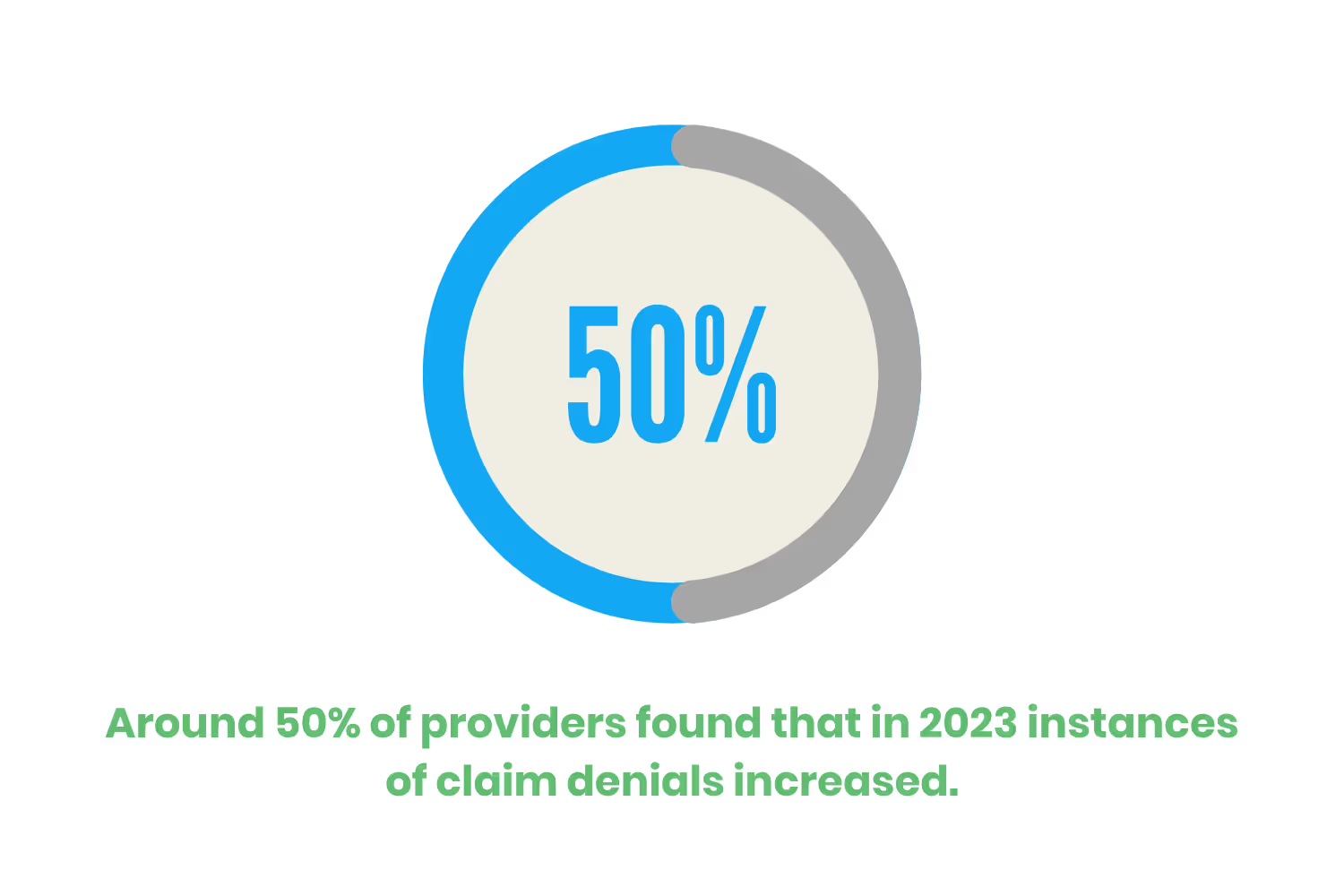
Today, we will dive deeper into when to use it, the differences, and how to fill it out. Prevention is the best medicine. Working diligently to avoid claim denials in the first place will save you money in the long run. It only makes sense to avoid any problems by educating you and your staff on the proper way to submit these forms!
What is the CMS-1500 Form?
The CMS-1500 form is a standard paper claim maintained by the National Uniform Claim Committee (NUCC). For reference, the NUCC is an industry organization that is in participation with the Centers for Medicare and Medicaid Services (CMS). Non-institutional providers commonly use this form to bill Medicare for patient services.
Individual healthcare services may include:
- Therapists.
- Physicians.
- Midwives.
- Dentists.
- Nurse Practitioners.

Interestingly enough, the Administrative Simplification Compliance Act (ASCA) requires that providers send Medicare claims electronically. This is unless certain exceptions arise. This brings us to the CMS-1500 form. Exceptions in which providers can use this paper form include:
- Situations in which a provider can demonstrate that the HIPAA claim standard does not allow submission of a certain kind of claim electronically.
- Disability of all members of a provider’s staff does not permit the use of computers. And therefore, does not permit the use of electronic claims.
- Other rare and unanticipated situations that are outside of a provider’s control. When CMS cannot enforce this requirement out of good conscience it could be against equity.
The term ‘providers’ in this case refers to physicians, suppliers, and other health care providers. When sending a claim via paper form, these providers must use the CMS-1500 form. This form goes by sections which house specific instructions for completion. Let’s go over these sections in more detail together.
Patient and Insured Information
The first section in the CMS-1500 form contains the patient information, as well as their insurance information. In this section, you can expect to cover the following patient information:
- Patient's name.
- Date of birth.
- Sex.
- Address.
- Phone number.
Once you have this data recorded, it is then time to cover the patient’s insurance information. An extremely important step to handle before providing medical services. This is critical as it safeguards your organization if a patient doesn’t have any insurance coverage. Meaning they will have to pay out of pocket for their services. Large medical bills can be overwhelming prompting patients to miss payments. Unexpected bills for your patients will ultimately leave your bottom line hurting.
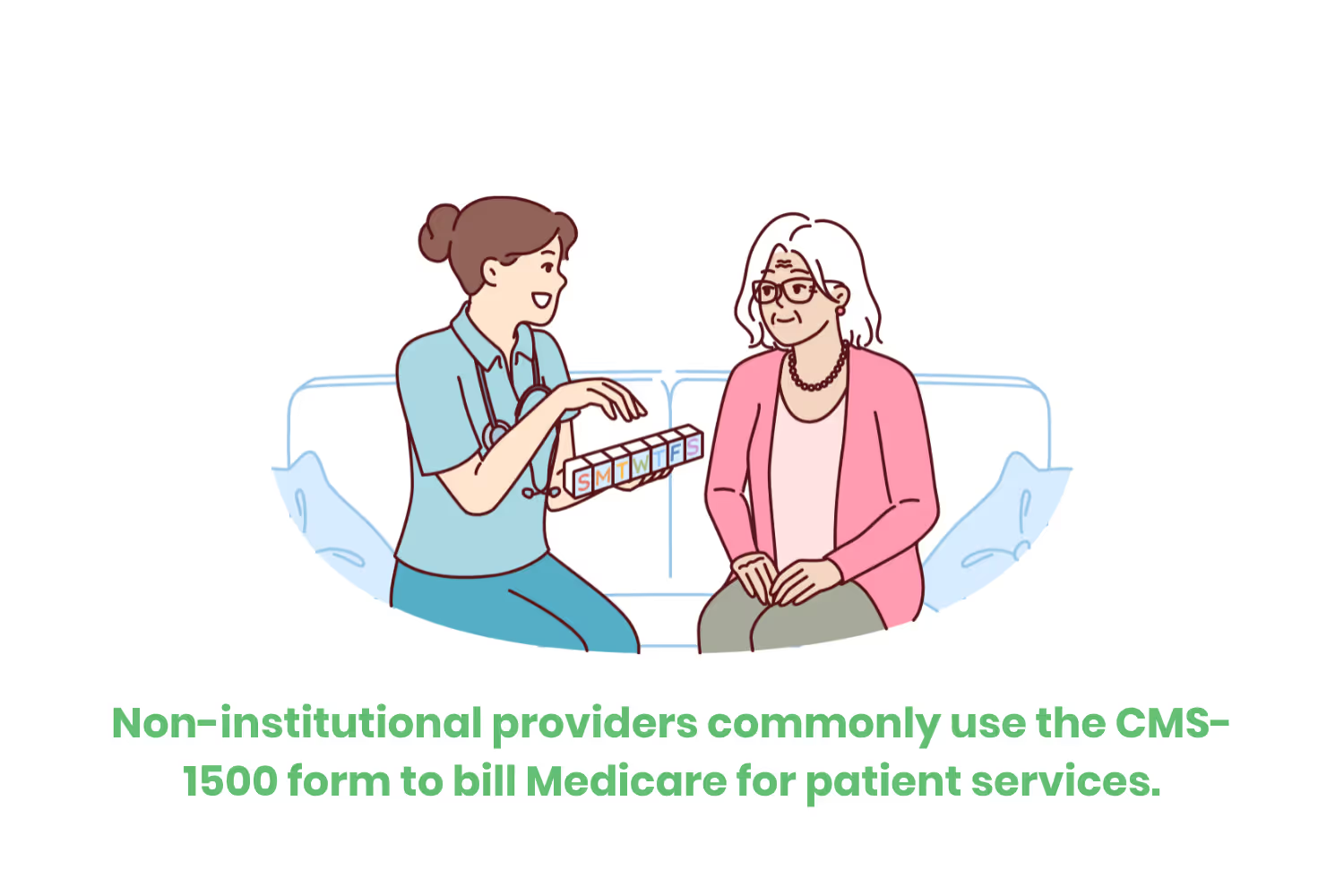
Insurance information to gather through the CMS-1500 form include:
- Patient's primary and (if they have it) secondary insurance.
- Patient’s relation to insured.
- The insured’s phone number and address.
- The insured’s date of birth and sex.
- Policy number or Federal Employees' Compensation Act (FECA) number.
- Group numbers.
- Payer IDs.
The patient must also provide their signature after gathering this information. This is vital for authorization and includes going over the release of medical information in order to process their claim. As well as authorizes payment of benefits to the provider or supplier for services rendered.
Physician or Supplier Information
Next is the physician or supplier information section of the CMS-1500 form. Be sure to document the physician or provider information on the form. Information to include is the:
- Name of referring, ordering, or supervising physician or provider.
- Work address.
- National Provider Identifier (NPI) number.
- Other identifying information such as date of service.
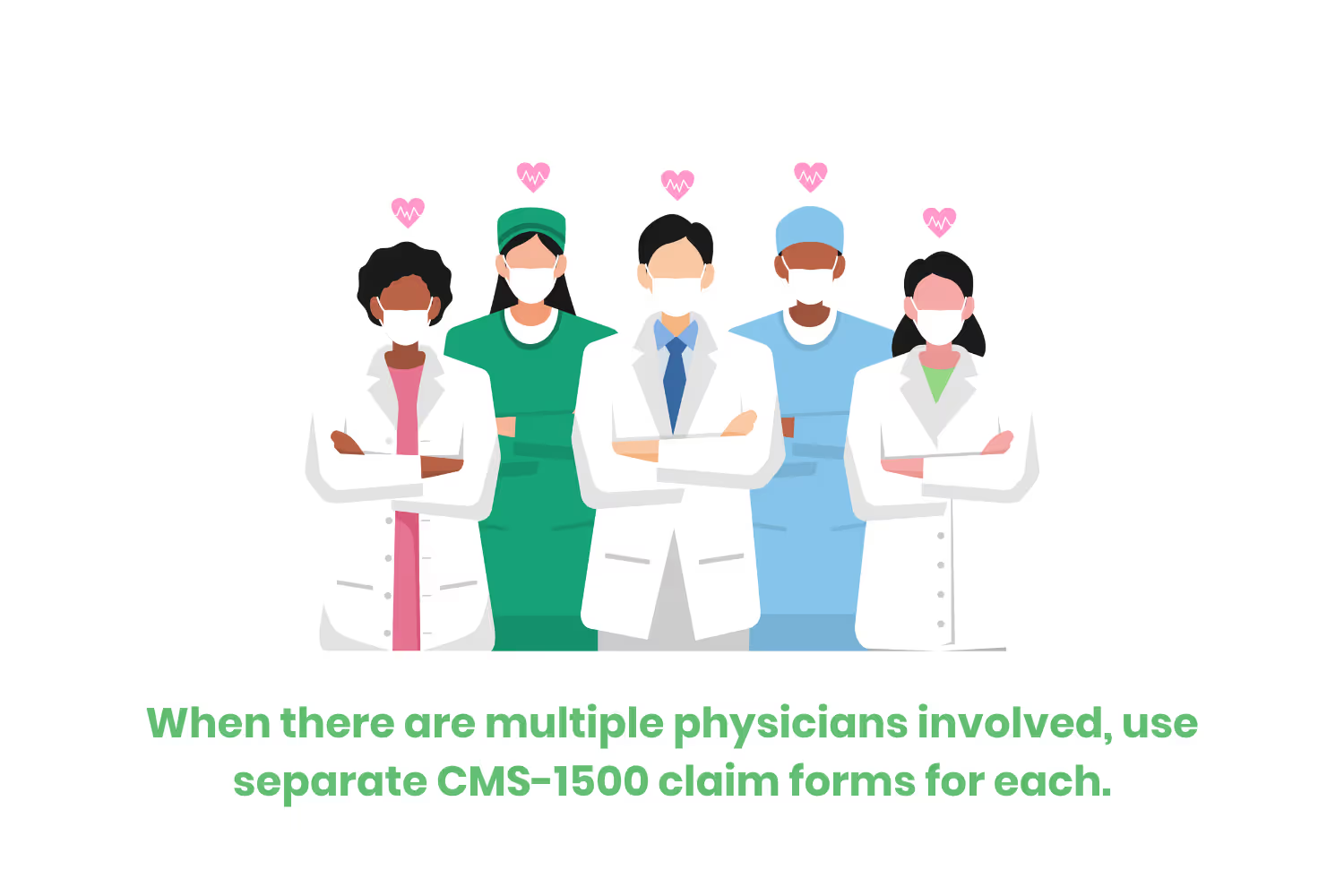
Note, that when there are multiple physicians involved, use separate CMS-1500 claim forms for each. Narrative fields in this section also cover different types of information that may help when submitting claims. Such as including the drug used in the service/procedure. Make note of its name, strength, and dosage when submitting a claim, especially for Not Otherwise Classified (NOC) drugs.
Prior authorization numbers, date of service, and place of service boxes are also important to fill out thoroughly. These narrative fields help to shed more light on the specifics of said claim when insurance is reviewing the data
Here you can also enter a description of an "unlisted procedure code”. You will most likely need to add an attachment to help move the claim along. Especially if more than one unlisted procedure code is present. But I’m getting ahead of myself. Let’s take a look at what to include on the CMS-1500 when it comes to diagnosis codes.
Diagnosis Codes
A diagnosis code consists of a combination of letters and numbers that help identify and categorize diseases and medical conditions in healthcare. The International Classification of Diseases, Tenth Revision, Clinical Modification (ICD-10-CM) helps to standardize these codes by the CMS.
Having these codes identified correctly on the CMS-1500 form is vital for accurate and quick claim processing. By entering these correctly, you can relate the date of service and any items used under the primary diagnosis for filing.
Remember to only enter one reference number or letter per line item.
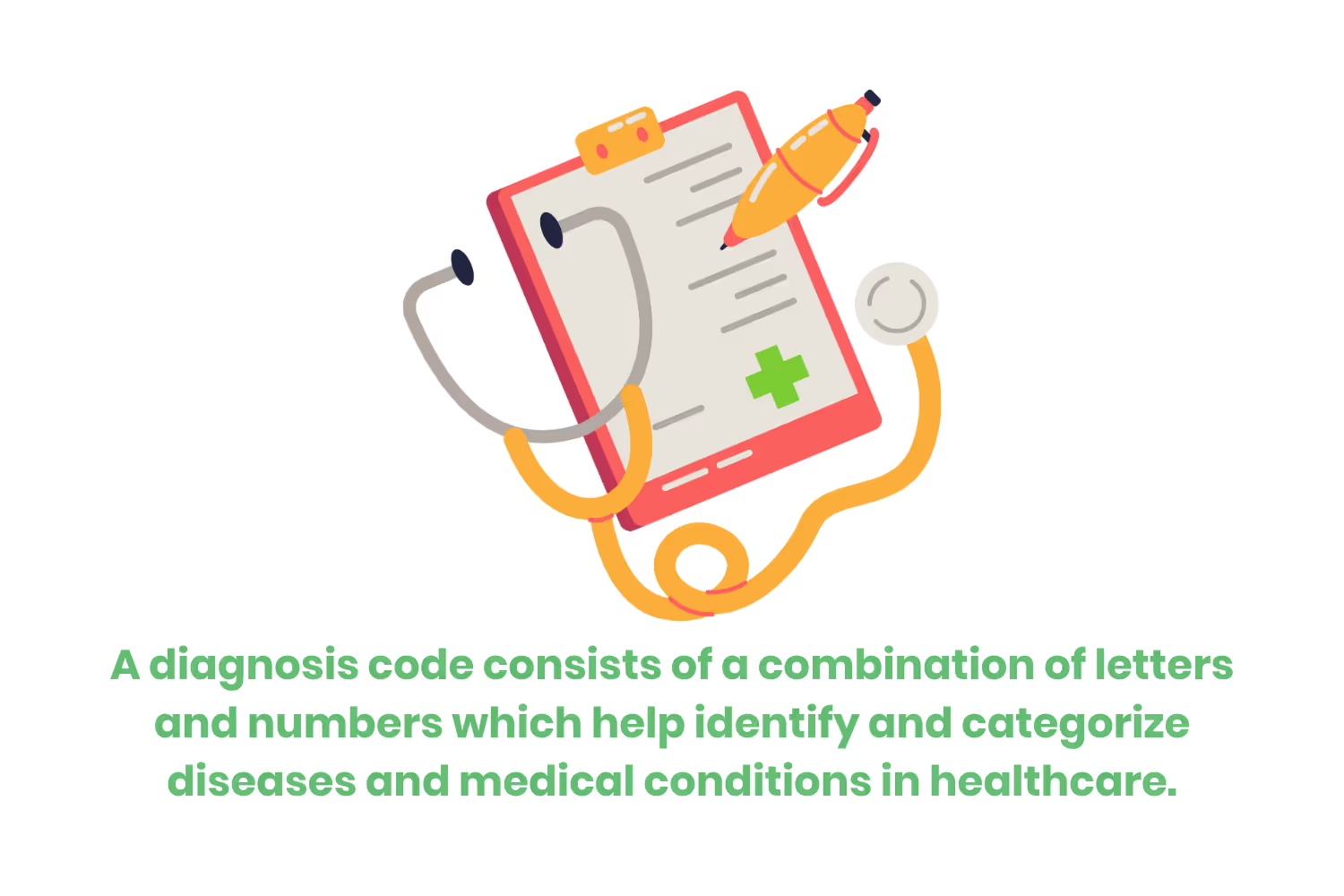
Procedure Codes
The procedure codes you will use under the CMS-1500 form are going to be Healthcare Common Procedure Coding System (HCPCS) codes. This coding system helps you to classify all medical procedures and services. Note that this coding system follows the American Medical Association’s (AMA) Current Procedural Terminology (CPT).
First, enter the HCPCS procedure code without a narrative description. On the other hand, if you report an “unlisted procedure code” or a “not otherwise classified” code, that will require a narrative description. As well as an attachment with additional information submitted with the claim form.
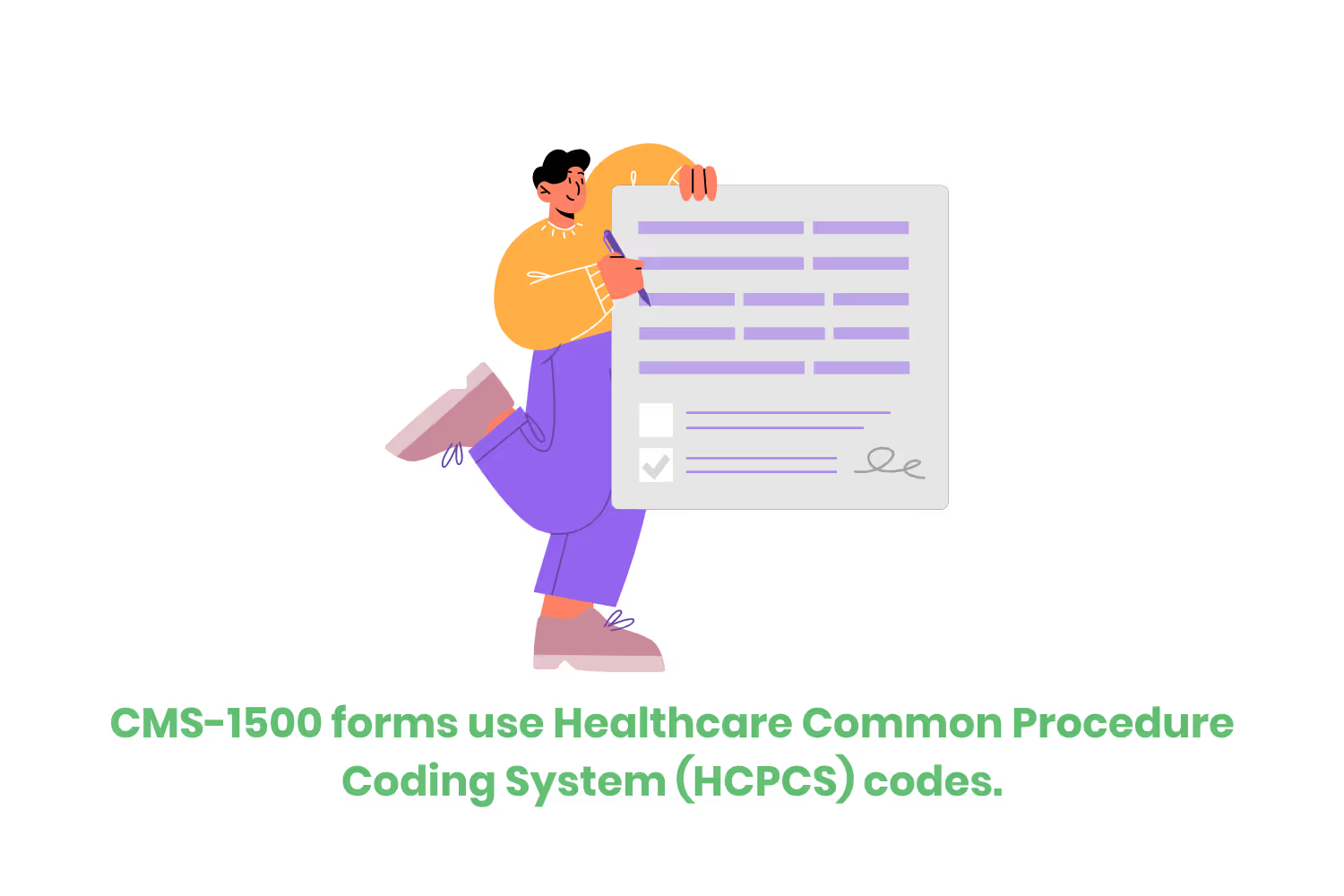
A narrative added to a claim can look like any of the following:
- Description of the item or service.
- Manufacturer name.
- Product name.
- Product model name and number.
- Supplier Price List (PL) amount.
- HCPCS code of related item.
- If a repair part, the HCPCS code of the item repaired.
If you need to use a modifier, show the HCPCS code modifier with the HCPCS code on the form. The CMS-1500 form can record up to four modifiers. If you need to use more than four modifiers, use modifier 99 as your fourth modifier to signal an “overflow”. You can then add the additional modifiers in item 19. Remember, when talking about modifiers they can be alphabetic, numeric, or both. However, they are always only two digits.
Charges
Finally, we have the fees. Specifically, the provider fees that wrap up CMS-1500 forms, depending on the services listed. Be sure to include cents along with the dollar amounts. Don’t use decimals, dashes, commas, lines, or dollar signs. An example might look like writing 2100 instead of $21.00. Negative dollar signs are also not allowed.
For an electronic claim submission, you can submit up to seven characters in any dollar amount field. Anything higher than this will result in a claim rejection. To submit a total claim over this amount, submit two separate claims splitting the overall charge. Make sure the dollar amounts are different to avoid duplication issues.
Conclusion
The CMS-1500 form is a critical tool when it comes to correctly submitting healthcare claims efficiently.
While filling out any medical billing form, your team should always adhere to the following key principles:
- Accuracy and thoroughness.
- Timeliness.
- Compliance.
- Leveraging healthcare billing software.
By doing this, you can rest assured your billing process is better streamlined and without errors. Staying informed on changing regulations and consulting with a clearinghouse on your submitted claims will strengthen your financial health in the long run.
Emphasize your product's unique features or benefits to differentiate it from competitors
In nec dictum adipiscing pharetra enim etiam scelerisque dolor purus ipsum egestas cursus vulputate arcu egestas ut eu sed mollis consectetur mattis pharetra curabitur et maecenas in mattis fames consectetur ipsum quis risus mauris aliquam ornare nisl purus at ipsum nulla accumsan consectetur vestibulum suspendisse aliquam condimentum scelerisque lacinia pellentesque vestibulum condimentum turpis ligula pharetra dictum sapien facilisis sapien at sagittis et cursus congue.
- Pharetra curabitur et maecenas in mattis fames consectetur ipsum quis risus.
- Justo urna nisi auctor consequat consectetur dolor lectus blandit.
- Eget egestas volutpat lacinia vestibulum vitae mattis hendrerit.
- Ornare elit odio tellus orci bibendum dictum id sem congue enim amet diam.
Incorporate statistics or specific numbers to highlight the effectiveness or popularity of your offering
Convallis pellentesque ullamcorper sapien sed tristique fermentum proin amet quam tincidunt feugiat vitae neque quisque odio ut pellentesque ac mauris eget lectus. Pretium arcu turpis lacus sapien sit at eu sapien duis magna nunc nibh nam non ut nibh ultrices ultrices elementum egestas enim nisl sed cursus pellentesque sit dignissim enim euismod sit et convallis sed pelis viverra quam at nisl sit pharetra enim nisl nec vestibulum posuere in volutpat sed blandit neque risus.

Use time-sensitive language to encourage immediate action, such as "Limited Time Offer
Feugiat vitae neque quisque odio ut pellentesque ac mauris eget lectus. Pretium arcu turpis lacus sapien sit at eu sapien duis magna nunc nibh nam non ut nibh ultrices ultrices elementum egestas enim nisl sed cursus pellentesque sit dignissim enim euismod sit et convallis sed pelis viverra quam at nisl sit pharetra enim nisl nec vestibulum posuere in volutpat sed blandit neque risus.
- Pharetra curabitur et maecenas in mattis fames consectetur ipsum quis risus.
- Justo urna nisi auctor consequat consectetur dolor lectus blandit.
- Eget egestas volutpat lacinia vestibulum vitae mattis hendrerit.
- Ornare elit odio tellus orci bibendum dictum id sem congue enim amet diam.
Address customer pain points directly by showing how your product solves their problems
Feugiat vitae neque quisque odio ut pellentesque ac mauris eget lectus. Pretium arcu turpis lacus sapien sit at eu sapien duis magna nunc nibh nam non ut nibh ultrices ultrices elementum egestas enim nisl sed cursus pellentesque sit dignissim enim euismod sit et convallis sed pelis viverra quam at nisl sit pharetra enim nisl nec vestibulum posuere in volutpat sed blandit neque risus.
Vel etiam vel amet aenean eget in habitasse nunc duis tellus sem turpis risus aliquam ac volutpat tellus eu faucibus ullamcorper.
Tailor titles to your ideal customer segment using phrases like "Designed for Busy Professionals
Sed pretium id nibh id sit felis vitae volutpat volutpat adipiscing at sodales neque lectus mi phasellus commodo at elit suspendisse ornare faucibus lectus purus viverra in nec aliquet commodo et sed sed nisi tempor mi pellentesque arcu viverra pretium duis enim vulputate dignissim etiam ultrices vitae neque urna proin nibh diam turpis augue lacus.




